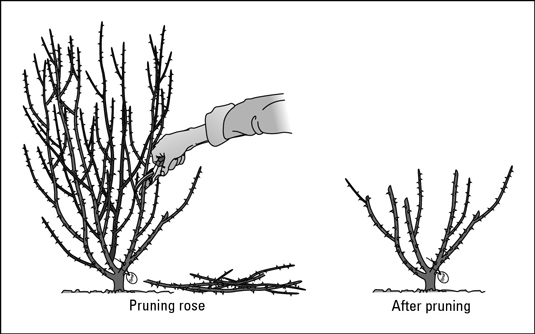By Steven A. Frowine and The National Gardening Association from Gardening Basics For Dummies
Roses have a reputation for being difficult to care for, but with the correct amount of water and sunlight and a little bit of grooming, your roses should thrive. Explore these basics of caring for your roses — but if you forget or muff something, the plants are surprisingly forgiving:
Watering roses: The rule of thumb is to make sure roses get about 2 inches a week. Deep soakings are much better than frequent, shallow waterings. Set the hose at the foot of the rose and let water trickle in. Or if you have a big bed of roses or roses and companions, use a soaker hose or install an in-ground system.
Fertilizing roses: Use an all-purpose garden fertilizer, because it has balanced amounts of N (nitrogen), P (phosphorus), and K (potassium). Fertilizers touted especially for roses — such as Rose Food — are fine but not mandatory. In spring, as the plant emerges from dormancy, you can water with a tablespoon of Epsom salt (magnesium sulfate) dissolved in a gallon of water to promote strong canes.
Always water before applying fertilizer so the plant is plumped up and under no stress.
Grooming roses: Using sharp clippers, you can spruce up your rosebushes whenever something unattractive about the plant catches your critical eye.
Here’s stuff you can cut out any time you see it:
Dead wood: Remove dead canes down to the ground level.
Damaged wood: Cut it back into about 1 inch of healthy wood.
Misplaced stems: Take off stems that are rubbing together (choose one and spare the other), stems that are taking off in the wrong direction, and stems that are trailing on the ground.
Suckers: In a grafted plant, these errant canes emerge from below the graft union (the bulge at the base of the bush). The suckers look different from the rest of the bush — they’re often smoother, straighter, and lighter in color. Another clue: They sprout leaves and occasionally mongrel flowers that look nothing like the main bush.
Deadheading and tidying up roses: The plant looks better when you get rid of spent flowers. Also, because the goal of all flowering plants is to stop flowering and produce seed (in the case of rosebushes, to make rose hips), deadheading thwarts the process. So the plant is fooled into making more flowers. Deadhead away!
Whenever you see badly damaged, diseased, or dead leaves, remove them. To be on the safe side, throw them in the trash rather than in the compost pile. Otherwise, the leaves may spread disease.
Pruning roses: Early spring is the best time to prune. If it’s still winter, your overeager cuts may lead to frost damage. Pruning is pretty straightforward: Remove all non-negotiable growth, thin the plants, and then shape them.
Experts advise cutting 1/4 inch above a bud eye so the bud eye doesn’t dry out.

Use clean, sharp clippers, and cut at a 45-degree angle. Cut near a bud eye, the tiny brownish or reddish bump on the stem (not to be confused with a thorn).
By dummies.com